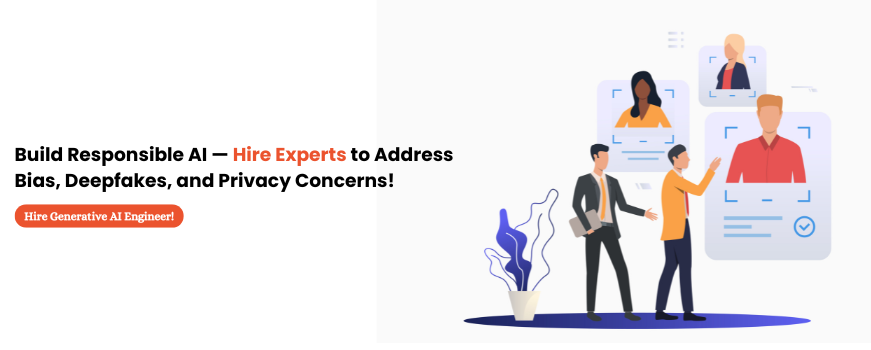
Ethical Concerns in Generative AI: Tackling Bias, Deepfakes, and Data Privacy

Generative AI has become a modern life requirement. We use these models to perform a wide range of tasks. From writing human-like content to crafting realistic images and videos, everything is simple using AI. It has become a popular tool across various industries, such as marketing, healthcare, and entertainment.
Therefore, most companies are open to hiring generative AI experts and engineers to help them make the most of it. Along with all the great things generative AI can do, there are also some big ethical issues we need to think about. Problems like AI showing bias, the rise of deepfakes, and data privacy concerns are making people question how safe this technology is. If not handled carefully, these issues can harm both individuals, organizations, and society at large.
In this article, we’ll explore the major ethical concerns in Generative AI questions and easy actions businesses can take to create AI wisely. Let’s start by understanding what bias is.
What is Bias in Generative AI?
In simple terms, bias means leaning toward a particular group. Bias in generative AI refers to the anomaly of AI models. It favors one specific group and creates results that are unfair or biased. It is usually due to the improper training dataset of AI models.
If the data contains inequalities and unfair views from the population, the AI will learn those same biases. Thus, it provides unfair output for a particular group of people. The second reason can be training models on historical data. By doing so, the AI detects bias patterns, resulting in a biased output. Other reasons can be a wrong label in the input data or a simple model. To understand it better, let’s see the types of bias.
Types of Bias in Generative AI
There are many types of bias in generative AI. They are:
- Sample Bias: This bias generally occurs when we select the wrong sample from the population. In simple words, it’s similar to asking only kids about their favorite TV shows and using every age group to recommend shows.
- Historical Bias: This bias occurs when you train your AI model using out-of-date data. In simple words, it’s similar to exploring a new city using an old map.
- Label Bias: When our input data has wrong labels, our AI model will reflect these errors in output.
- Evaluation Bias: If you train your AI model with limited data, this bias occurs. In simple words, it’s similar to testing your new cars only on smooth roads.
How to Reduce Bias in Generative AI?
For your ethical AI development, you should focus on how to reduce bias. Till now, we have covered the definition and types of bias. Now, let’s see the practical steps to reduce bias:
- Diverse Datasets: The very basic step to avoid bias in your system is to use a diverse dataset for training your model.
- Data Augmentation: It consists of methods like scaling, cropping, flipping, rotating, etc. to convert the raw data into our desired format.
- Re-sampling Data: It is required to balance your model by understanding different categories of data.
- Constant Monitoring: This means keeping an eye out for potential bias in both your data and the sources it comes from.
- Adversarial Training: For this technique, two neural networks are used such that one will give the output and the other will validate the output.
- Transparency: Try to be clear about how your AI model is developed, including where the data comes from and what is done to fix any bias.
- Bias Detection Tools: Some tools on the market can help you detect bias in your system. So, using specialized tools is also a good idea to identify potential biases using bias metrics in the training data.
What are Deep Fakes?
Have you seen the widely shared video of President Zelensky declaring the surrender of Ukraine? If the answer is yes, you have probably seen a deepfake.
Deep Fakes are nothing but videos or audio recordings that are fake, crafted using artificial intelligence. This content looks and sounds real, and it can create the illusion that someone is talking or doing something they have never done.
For example, a deepfake might feature a well-known actor delivering dialogue from a film they didn’t act in. You can also think of a deepfake video of a politician making a speech they never gave. This is done by teaching the AI model to analyze real videos and audio. After this, they create new ones that seem very real.
How to Address Deepfakes in Generative AI?
Now, let’s learn how to handle deepfakes because it is important to keep people safe. Also, it is vital to guarantee the accuracy of the content. The following simple steps can help lower the chance of deepfakes:
- Education and Awareness
You can start by informing people about the features of deepfakes and how to identify them. The more everyone understands these generative AI technologies, the better they can spot fake videos and audio. In general, when viewing any online content, pay attention to any content that looks strange. For example, odd expressions, settings, or if the voice doesn’t match the person’s lips. Always double-check for the sources.
- Verify Sources
It’s better to always find out the sources of a video or audio sample before believing anything. You can do this by looking for official accounts or reliable news sources when searching for videos. By doing this, you can stay away from deepfakes.
- Promote Transparency
You should do this by asking content producers about their sources and efforts. This will also help viewers to identify deep fakes more quickly. If someone is editing a video, they should add labels or watermarks. This indicates to users that they have been edited or created using artificial intelligence. Thus, it reduces the overall risk of spreading fake news amongst people.
- Detection Tools
Last but not least, you can use some tools like Sentinel, Sensity, and WeVerify to find deepfakes. These tools look for clues that a video might be fake. These clues can be odd facial movements or odd licking. This is a research field. Generative AI engineers are working on improving these detection methods.
Importance of Data Privacy
A data privacy breach happens when the data you have submitted to a trusted website is accessed by a third party without authorization. Over the years, various companies have seen data breaches in which names, phone numbers, bank details, and social security numbers have been accessed and leaked. These breaches remind us of the importance of data privacy.
Data privacy means protecting all your data, like your phone number, email, or financial details. It avoids sharing your data with third parties without your permission. It is important because if this data comes into the wrong hands, it results in various cybercrime activities. For example, hacking your system, fraud, or even stealing your identity.
How Can Generative AI Ensure Data Privacy?
Data privacy is one of the crucial ethical concerns when using generative AI technologies. The following practical steps help to ensure data privacy:
- Data Minimization: It means collecting only important data. It is always better to gather and utilize only the data needed for your AI model. Eventually, this will reduce the possibility of privacy problems and help protect sensitive data.
- Encryption: To ensure the safety of your data storage, you should use data encryption methods and manage who has access to it. This guarantees that no one can access or use the data without authorization.
- Masking Data: You should be careful to eliminate any sensitive personal information from data before using it to train AI models. That means you should modify names, addresses, and other sensitive data so that they cannot be linked to specific people.
- Education and Awareness: Awareness is the key to ensuring online safety. You can do this by instructing your team about the importance of data privacy. Also, you can arrange some workshops to train staff about methods to implement it. This ensures everyone involved in ethical AI development is aware of their duties for the handling of personal data.
- Following Regulations: Your team should follow relevant data privacy rules. By following these protocols and rules you can reduce risks of generative AI while still preserving individual rights. It will help foster a user’s trust in your AI systems.
The Bottom Line
Generative AI is an effective tool. It has the potential to completely change sectors. Along with all the great things generative AI can do, there are also some big ethical issues we need to think about. These ethical issues are bias, deepfakes, and data privacy.
By considering these concerns, businesses can develop more ethical AI models. Some simple, practical steps like diverse datasets, data augmentation, re-sampling data, constant monitoring, and adversarial training can help to avoid bias in generative AI. Similarly, verifying sources, transparency, and detection tools can help to reduce problems caused by deepfakes.
At the end of the day, it’s about balancing AI’s benefits and the need to ensure that it doesn’t negatively impact people or society. By solving these concerns, businesses may employ AI properly and gain the trust of their people.


FAQs
- How do regulations help overcome the ethical dilemmas in generative AI?
The only significant issue with generative AI is accountability. Proper regulations can ensure accountability of data, which may then invoke transparency and user protection. In the case of such AI softwares, developments and deployment are guided by regulations.
- Can societal values influence the development of generative AI?
Yes! Societal values help shape the guidelines for the development of generative AI. Understanding cultural sensitivities, ethical concerns, and societal norms can help in the watchful and mindful development of AI.
- Can bias affect generative AI?
Yes! Generative AI is based on pattern recognition. Hence, the content generated is not factually verified, and any accuracy of this data is usually coincidental.































































































































































































































































































































































































































































































































































































































































































































































